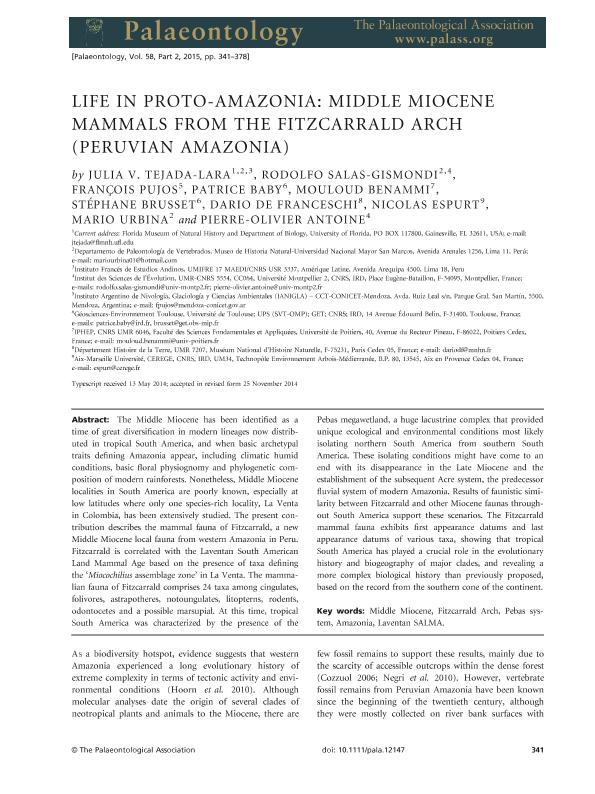Artículo
Life in proto-Amazonia: Middle Miocene mammals from the Fitzcarrald Arch (Peruvian Amazonia)
Tejada Lara, Julia V.; Salas Gismondi, Rodolfo; Pujos, François Roger Francis ; Baby, Patrice; Benammi, Mouloud; Brusset, Stéphane; De Franceschi, Dario; Espurt, Nicolas; Urbina, Mario; Antoine, Pierre Olivier
; Baby, Patrice; Benammi, Mouloud; Brusset, Stéphane; De Franceschi, Dario; Espurt, Nicolas; Urbina, Mario; Antoine, Pierre Olivier
 ; Baby, Patrice; Benammi, Mouloud; Brusset, Stéphane; De Franceschi, Dario; Espurt, Nicolas; Urbina, Mario; Antoine, Pierre Olivier
; Baby, Patrice; Benammi, Mouloud; Brusset, Stéphane; De Franceschi, Dario; Espurt, Nicolas; Urbina, Mario; Antoine, Pierre Olivier
Fecha de publicación:
03/2015
Editorial:
Wiley Blackwell Publishing, Inc
Revista:
Palaeontology
ISSN:
0031-0239
Idioma:
Inglés
Tipo de recurso:
Artículo publicado
Clasificación temática:
Resumen
The Middle Miocene has been identified as a time of great diversification in modern lineages now distributed in tropical South America, and when basic archetypal traits defining Amazonia appear, including climatic humid conditions, basic floral physiognomy and phylogenetic composition of modern rainforests. Nonetheless, Middle Miocene localities in South America are poorly known, especially at low latitudes where only one species-rich locality, La Venta in Colombia, has been extensively studied. The present contribution describes the mammal fauna of Fitzcarrald, a new Middle Miocene local fauna from western Amazonia in Peru. Fitzcarrald is correlated with the Laventan South American Land Mammal Age based on the presence of taxa defining the 'Miocochilius assemblage zone' in La Venta. The mammalian fauna of Fitzcarrald comprises 24 taxa among cingulates, folivores, astrapotheres, notoungulates, litopterns, rodents, odontocetes and a possible marsupial. At this time, tropical South America was characterized by the presence of the Pebas megawetland, a huge lacustrine complex that provided unique ecological and environmental conditions most likely isolating northern South America from southern South America. These isolating conditions might have come to an end with its disappearance in the Late Miocene and the establishment of the subsequent Acre system, the predecessor fluvial system of modern Amazonia. Results of faunistic similarity between Fitzcarrald and other Miocene faunas throughout South America support these scenarios. The Fitzcarrald mammal fauna exhibits first appearance datums and last appearance datums of various taxa, showing that tropical South America has played a crucial role in the evolutionary history and biogeography of major clades, and revealing a more complex biological history than previously proposed, based on the record from the southern cone of the continent.
Palabras clave:
Amazonia
,
Fitzcarrald Arch
,
Laventan Salma
,
Middle Miocene
,
Pebas System
Archivos asociados
Licencia
Identificadores
Colecciones
Articulos(IANIGLA)
Articulos de INST. ARG. DE NIVOLOGIA, GLACIOLOGIA Y CS. AMBIENT
Articulos de INST. ARG. DE NIVOLOGIA, GLACIOLOGIA Y CS. AMBIENT
Citación
Tejada Lara, Julia V.; Salas Gismondi, Rodolfo; Pujos, François Roger Francis; Baby, Patrice; Benammi, Mouloud; et al.; Life in proto-Amazonia: Middle Miocene mammals from the Fitzcarrald Arch (Peruvian Amazonia); Wiley Blackwell Publishing, Inc; Palaeontology; 58; 2; 3-2015; 341-378
Compartir
Altmétricas



